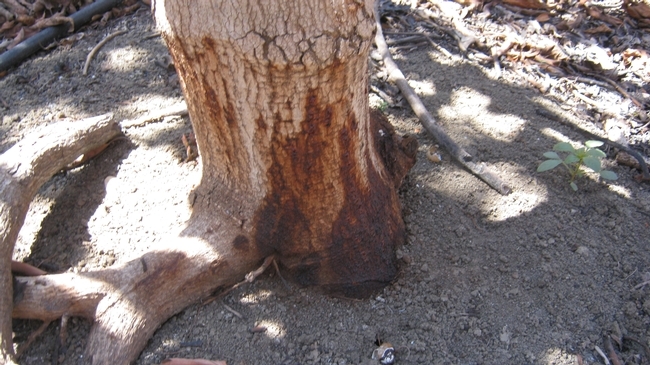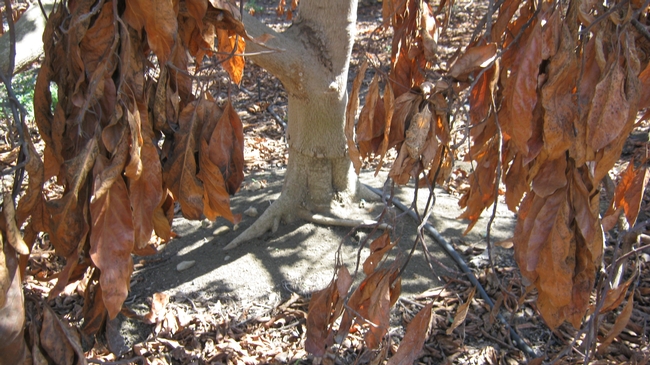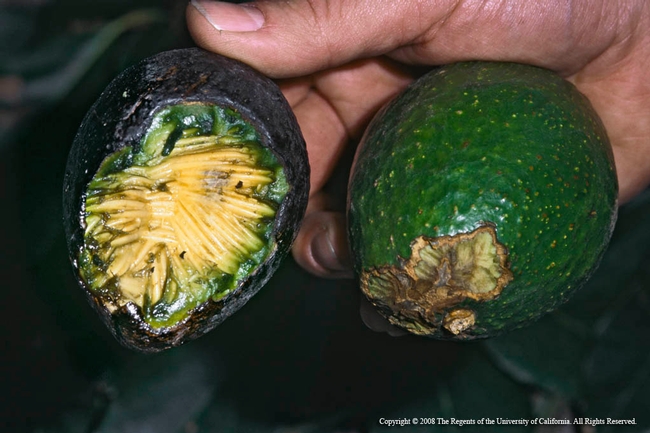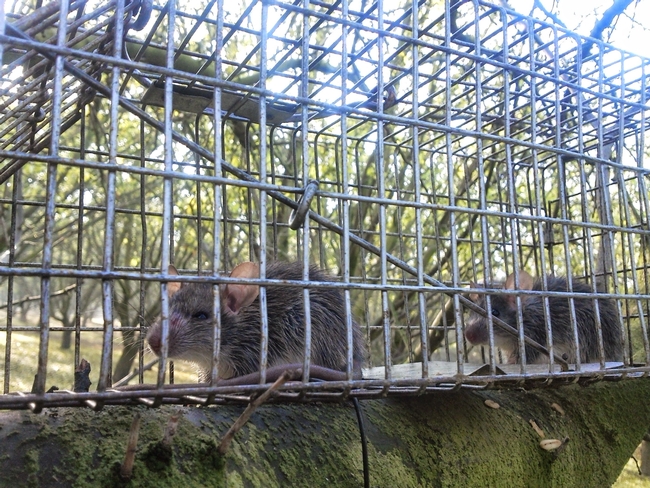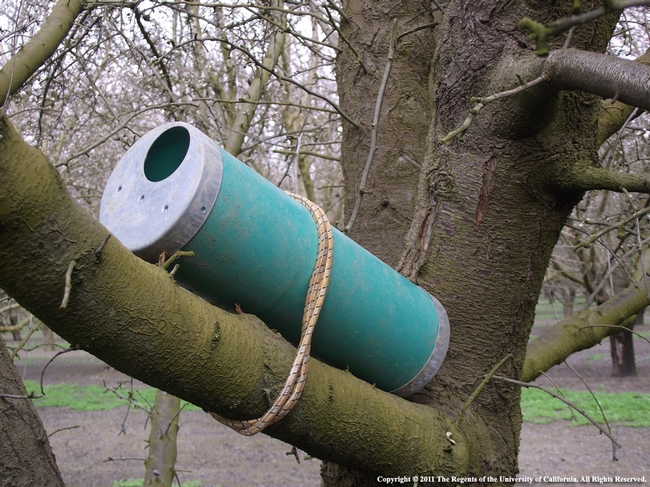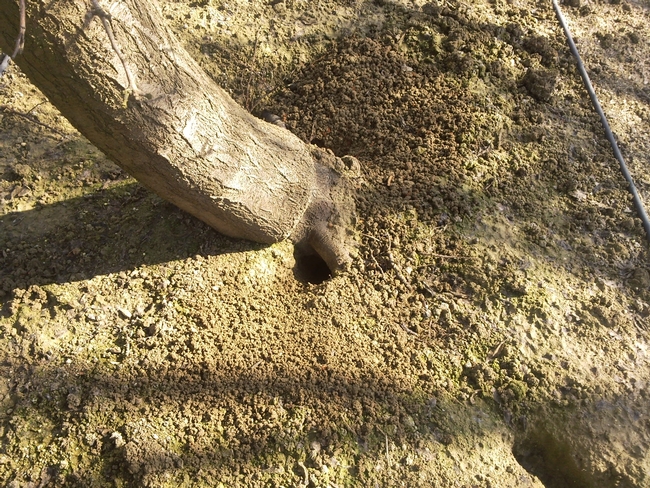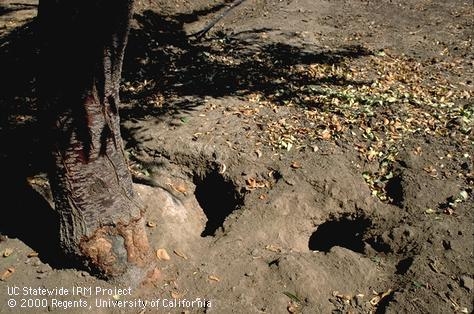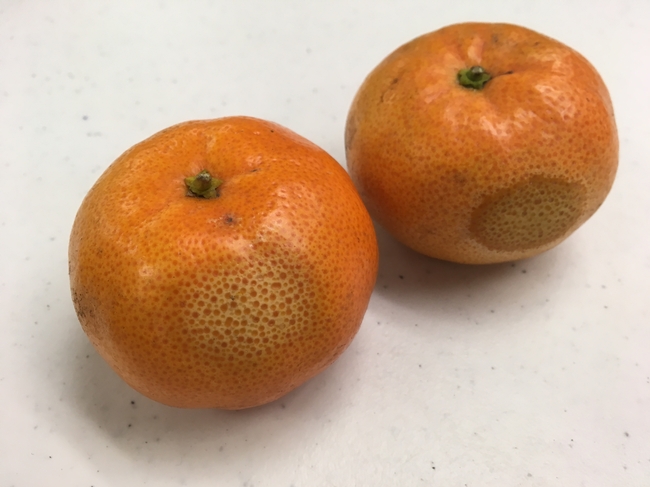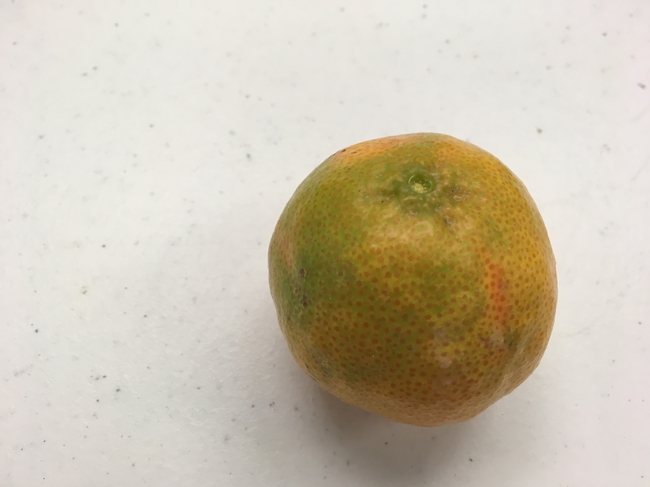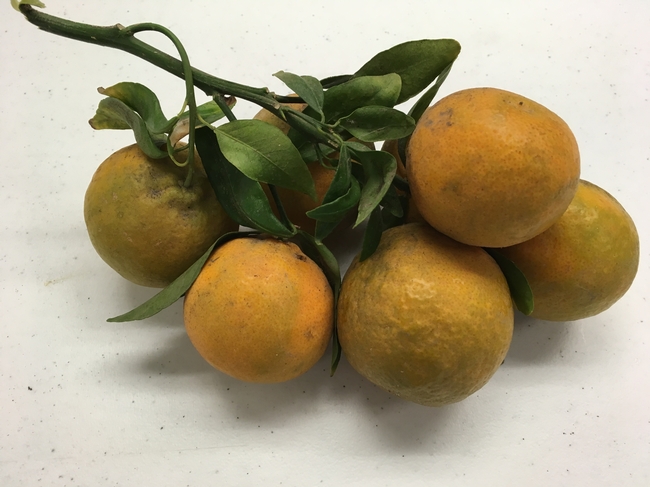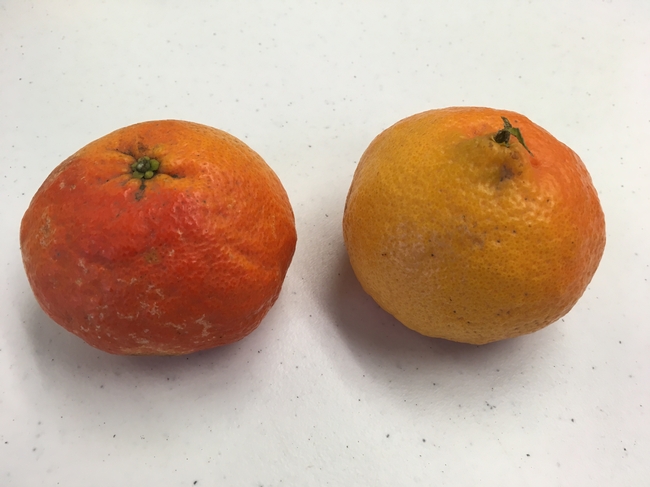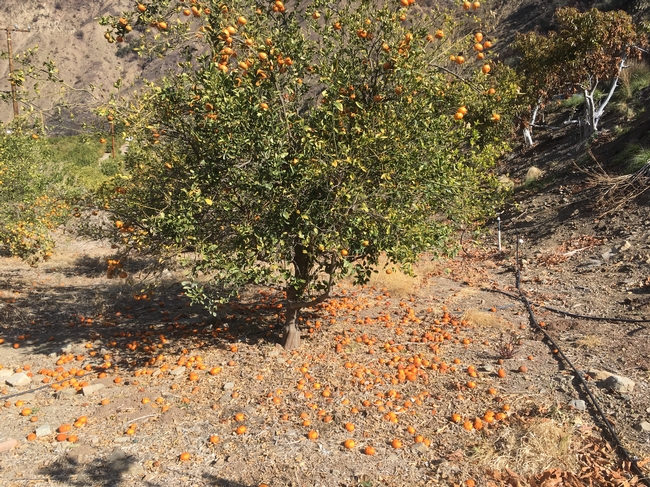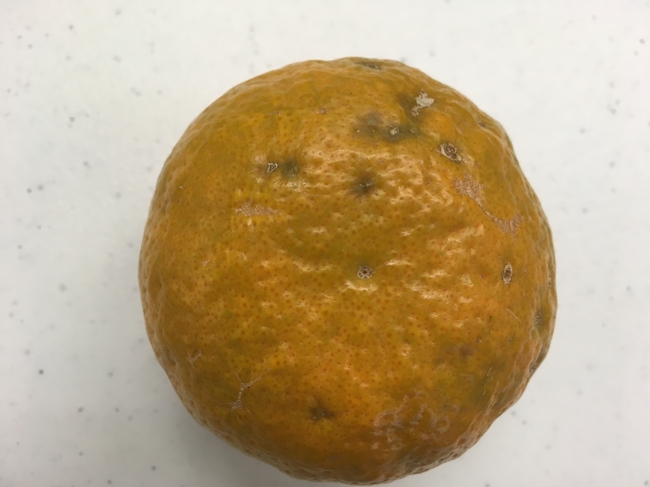- Author: Pam Kan-Rice
Roof rats are running rampant in California orchards this year, according to UC Agriculture and Natural Resources scientists.
“In pistachio and other nut orchards, roof rats are burrowing and nesting in the ground where they're chewing on irrigation lines, causing extensive damage,” said Rachael Long, UC Cooperative Extension advisor. “They are also nesting in citrus trees, feeding on the fruit and terrifying field workers when they jump out as people are picking fruit. The chewing pests are also girdling citrus limbs, causing branch dieback.”
The wet winter of 2017 led to lots of weed seeds for rats to eat. “Last season, rats were also nibbling on pomegranates, avocados, and other fruit and nut crops, rendering them unmarketable,” Long said.
Holes in the ground around the base of pistachio trees throughout a Yolo County orchard puzzled the grower.
“We looked for ground squirrels, but never saw any,” Long said. “We set up game cameras, but only got birds and rabbits. We put rodent bait in the holes, but the digging didn't stop.”
Long, the pest detective, cracked the case by consulting Niamh Quinn, UC Cooperative Extension human-wildlife interactions advisor based in Irvine. “She informed us that the damage we were seeing was from roof rats.”
Burrowing roof rats sounds like an oxymoron. While roof rats generally don't burrow in urban environments, their country cousins have been known to burrow.
“It's not true that they don't burrow,” Quinn said. “When I worked as staff research associate for Roger Baldwin, UC Cooperative Extension wildlife specialist, that is mostly what we studied, burrowing roof rats in orchards.”
Control measures
Baldwin said, “It seems to be a good year for rats in a number of different areas and crops throughout the state. I've received more questions and comments about rats this year than perhaps the last 10 years combined. As for bait application, putting bait down burrow systems for rats doesn't usually work too well, so I'm not surprised that approach didn't work. Growers will likely have better luck with bait stations in the trees.”
Because the rats climb, Baldwin suggests attaching bait stations to tree branches.
“In addition, elevating the bait stations will eliminate access to bait for many protected mammal species, such as kangaroo rats,” Long said. “The bait diphacinone grain can be purchased from some ag commissioners' offices. This is what Roger Baldwin said they tested and it worked.”
As for the bait stations, they should be designed so that there isn't any spillage for nontarget animals to eat, Long said.
When roof rat outbreaks occur, rodenticides are often needed to prevent crop damage. However, timing is critical as diphacinone use is highly restrictive and not allowed during the growing season, which is beginning as the weather warms.
“Check the product label for application instructions,” Long reminds growers. “It's the law.”
Identifying the pest
One way for growers to identify whether they have roof rats is by the size of the burrows. The nocturnal pests are active above ground in trees and below ground.
“Roof rats can forage away from their nest, so you won't likely find signs of their activity, such as rat droppings outside their burrow, to help identify them,” Long said.
Ground squirrels are active during the day, so they are more likely to be seen, dig holes about 4 inches in diameter and forage above ground near their burrows. Vole and mouse holes are 1- to 2-inches in diameter. Roof rat holes are typically 3 to 4 inches in diameter and might have nut shells in front of them, for example pistachio or almond shells. Rabbits will feed on seedling crops, but do not dig burrows.
Roof rats are prolific breeders that reproduce year-round, according to Baldwin. Females typically have three to five litters per year with five to eight young, enabling their populations to rapidly increase. The omnivores feed on a wide variety of plant and animal materials, allowing them to adapt to any environment, including urban and agricultural lands.
“Rats are sneaky and hard to spot,” Long said. “If you see damage, including digging in the soil but no wildlife, suspect rats.”
For more information on controlling roof rats, download Quinn and Baldwin's free UC ANR publication 8513, Managing Roof Rats and Deer Mice in Nut and Fruit Orchards at http://anrcatalog.ucanr.edu/Details.aspx?itemNo=8513.
For more information about ground squirrels, download the free UC IPM Best Management Guidelines http://www.groundsquirrelbmp.com or UC IPM Pest Note http://ipm.ucanr.edu/PMG/PESTNOTES/pn7438.html.
And there's more on rats in the orchard:
https://ucanr.edu/blogs/blogcore/postdetail.cfm?postnum=26570
https://ucanr.edu/blogs/blogcore/postdetail.cfm?postnum=24581
https://ucanr.edu/blogs/blogcore/postdetail.cfm?postnum=19525
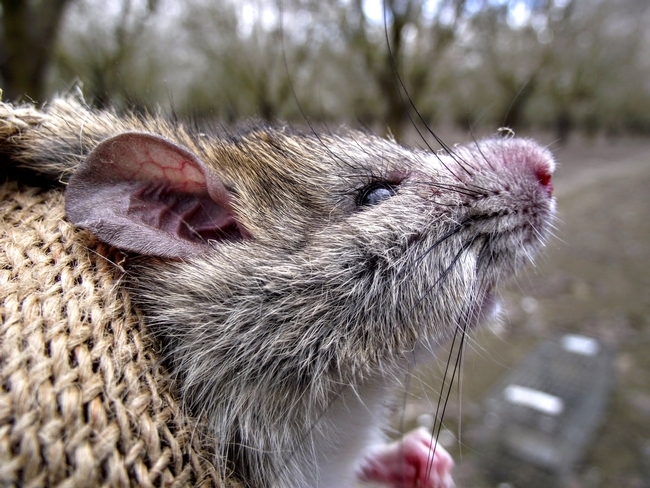
- Author: Ben Faber
Mandarins, also known as “zipper skins” and “easy peelers” can have very fragile peels/skins/rinds/exocarp that make them easily subject to more damage than most oranges and lemons. Some are a bit tougher skinned than others, but some are so fragile that any rough handling often prevents them from going through conventional packing operations.
These skins were recently put to the test in the recent fires in Ojai. There was a mix of different varieties - ‘Pixie', ‘Gold Nugget', ‘W. Murcott', ‘Yosemite Gold', ‘Tahoe Gold' and others. Some of them were more sensitive than others, some were closer to the fire, all were affected by smoke to some degree. In Matilija Canyon where smoke was present for many more days than in the east of the Ojai Valley and possibly more ash, the trees have started flowering sooner. That might be temperature difference, either cooler or warmer, so it is hard to say how much effect the smoke has had versus, the ash and/or heat. Smoke has many different gasses in it, one of which is ethylene which is a naturally occurring ripening agent. Smoke not only has gasses, but it occludes the sun so less or more or altered light might have an effect on these fruit. It's not a controlled experiment, so some little scientist is going to have to come along and wriggle out these different effects. Whatever. Fire and smoke have an effect on mandarins as we have seen in other crops, such as cherimoya, avocados and other citrus.
Heat damage. Fruit facing the fire.
Ash effects on fruit coloring. Fruit was covered with ash for several days until rain washed it off. Might be a pH effect (ash is alkaline), temperature effect, uneven light radiation, or other…….
Same sort of uneven coloring, that actually looks like an ashy color, but the ash has washed off the cluster by rain
And here's something interesting where fruit facing the fire is much lighter colored than fruit facing away from the fire. Here are two pieces of fruit, one from the side directly facing the fire, and the other from the other side of the tree. The side of that fruit facing the fire was also lighter colored. So, it had an effect through the canopy (small tree). The canopy was otherwise intact, unaffected heat or flames.
Oh yeah, and there is the characteristic fruit drop from either the heat, smoke gases, water stress or ….
And then there's the fruit that looks like it had actual embers on the skin.
If the tree survives and keeps its green leaves, sometimes the fruit is affected in ways that don't appear for a while. The peel may be affected, but in many cases the fruit is just as sweet as it could be. It just looks terrible. That might even be a selling point. "Here have a wonderous piece of history that braved the horror of the Ojai fires."
- Author: Ben Faber
When avocados are converted from one variety to another or in the case of severe frost or fire damage and there is still a healthy root system, sucker grafting should be considered. This can lead to more rapid production and is one of the easiest, most successful grafting procedures. It does take considerable attention to the graft and protection from damage by animals and overgrowth from competing suckers.
A detailed presentation of the process is found in a UC publication – Propagating Avocados, authored by Bob Whitsell, Grey Martin, BOB Bergh, Alvin Lypps and Hank Brokaw. This pamphlet was published in 1989 and is still the bible of avocado propagation. It mentions the use of parafilm as a wrapping material. It is now the standard for grafting and budding. Parafilm has pretty much replaced polyvinyl tape and asphalt emulsion for sealing and attaching the scions. It is a strong material, yet readily stretches to allow for bud growth. Where the grafts are exposed to the sun, this tape should also be painted white to protect the growing point from sunburn.
http://www.avocadosource.com/papers/research_articles/whitsellrh1989.pdf
And an older publication by E.O. Stromberg
http://www.avocadosource.com/CAS_Yearbooks/CAS_25_1940/CAS_1940_PG_89-91.pdf
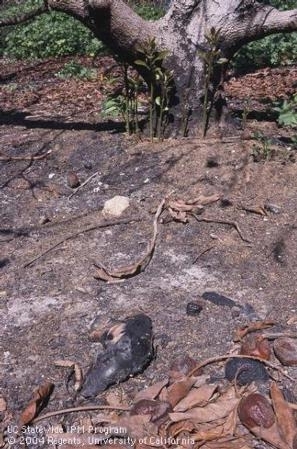
- Author: Ben Faber
As firefighters in Southern California worked to achieve full containment on the Thomas Fire, agricultural officials in Ventura County issued their first estimate of damage to crops and farm structures, reporting that losses will exceed $171 million, with more than 70,000 acres of cropland and rangeland affected.
The Ventura County agricultural commissioner's office based its initial assessment on information about agricultural locations within the perimeter of the fire, which started on Dec. 4 and grew into the state's largest wildfire, burning nearly 282,000 acres as of late last week.
In a preliminary disaster report to the U.S. Department of Agriculture, Ventura County Agricultural Commissioner Henry Gonzales estimated more than 10,289 acres of irrigated cropland and another 60,000 acres of rangeland in the county had been affected by the fire. He estimated the cost of the damage to current and future crops, machinery and equipment, dwellings, service buildings and other structures at nearly $171.3 million, with avocados and citrus crops suffering the highest losses.
The estimates do not include wage losses of farm employees, the report said, and “nothing can measure the pain and suffering of the farmers that have lost much of their livelihood.”
A more-exact assessment won't be completed until late spring to early summer, Gonzales said, as his office continues to conduct on-the-ground surveys and receive surveys back from growers. What's uncertain at this point, he said, is how well the tree crops will recover.
“The rather complicated part about damage on avocado and lemon trees is that the damage isn't readily apparent,” he said. “You can't really tell the damage until sometime in the future.”
Farmers will have a better idea in the spring, when their trees either bloom or won't bloom, Gonzales said. Even then, they won't know the extent of the trees' recovery until summer, when they can evaluate the crop itself. Aerial photography, he noted, will allow officials to see crop damage as it manifests.
In Santa Barbara County, which was also affected by the Thomas Fire, Assistant Agricultural Commissioner Rudy Martel said it will be a few more weeks before his office can provide an initial damage assessment. He noted it had been less than two weeks since mandatory evacuations in the region had been lifted, and growers had just begun to return to their properties.
“The growers have not been in contact with us,” he said. “We rely on their information, and it takes them a while to get those numbers to us because they're trying to get back into production, to start their business back up.”
He said he hopes a grower assistance workshop in Carpinteria later this week will provide the office its “first opportunity to touch base” with growers and gather initial damage estimates.
In Ventura County, the fire has so far cost avocado growers an estimated $10.2 million in losses, Gonzales reported. The county has about 18,500 acres of avocados, with 6,603 acres affected by the fire and 1,250 acres that suffered damage. Some 4,030 tons of fruit have been lost.
For citrus fruit, the county's lemon crop saw more than $5.8 million in losses, with 7,591 tons of lost fruit. Of the county's 14,800 acres of lemons, 1,767 acres were affected by the fire and 400 acres were damaged. Oranges suffered losses of about $3.4 million, while the cost to mandarins reached $491,022 and grapefruit losses totaled $35,930.
Other affected commodities include vegetables, with damage and losses totaling $4.6 million; miscellaneous fruit, $1.4 million; nursery crops, $1.4 million; strawberries, $486,416; rangeland, $480,000; apiaries, $139,500; hay and grain, $129,345; cattle, $125,000; cut flowers, $61,966; and raspberries, $55,420.

The preliminary estimate of nearly $171.3 million in agricultural losses in Ventura County from the Thomas Fire includes $25 million in lost farm machinery and equipment.
Photo/John Krist
Ventura County farmers and ranchers also face costs to replace and repair destroyed or damaged buildings, equipment and other structures. Gonzales estimated the fire destroyed 260 agricultural dwellings, service buildings and other structures. Another 215 buildings and structures suffered major or minor damage. Together, they were valued at a loss of $113 million.
The report estimated the cost to replace farm machinery and equipment at $25 million. Cost of land damages, including cost to replace trees, reached $3.4 million, while loss of irrigation systems totaled another $1.1 million.
“There were many homes, many structures that were lost,” Gonzales said. “Our very water-efficient irrigation systems, because they're made out of plastic, melted, so all of those will have to be replaced.”
Restoring irrigation systems is critical, he said, because of the region's ongoing drought conditions and lack of precipiation this season. Using water trucks is not an option, he added, because of the large number of affected acres that need watering. Because of high demand, he said there's been a local shortage of irrigation components, and some growers have had to order them or go out of the area to buy parts.
Mallory Salant, district manager of Fruit Growers Supply in Santa Paula, said the fire led to skyrocketing demand for certain items.
“Aboveground irrigation parts are flying off the shelves,” she said. “A couple of days after the fire started, we were completely out of stock and it was very chaotic in the showroom.”
Irrigation tubing is currently the most sought-after item. At other times, a typical order might be 10 or 20 rolls of tubing, she said, but now farmers are ordering 200 to 400 rolls because they need to replace all of the tubing on their farm.
Despite the high demand, Salant said the store has managed to “stay on top of it” by working with vendors to restock quickly.
“At this point, our shelves are full,” she said.
by Ching Lee, assistant editor of Ag Alert/credit California Farm Bureau Federation
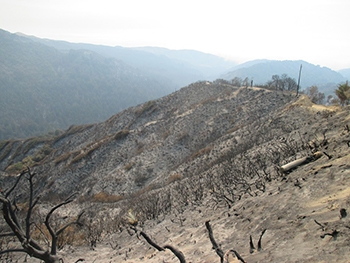
- Author: Ben Faber
The destruction after a fire can be pretty gruesome and sad. Many times, though the fire moves through the orchard so fast that, even though the canopy has turned brown, there is a good chance the trees can come back. It all depends on how much damage has been done to the trunk. If the fire has substantially damaged the base of the trunk, it is unlikely to come back, even if the canopy is still green. That is the saddest thing, because you think you've dodged the bullet, but if the trunk is too damage, the canopy collapses gradually over a few weeks. However, the canopy may look a goner, but if the trunk is still intact, the tree will come back and may still be as productive as before.
The thing to look for at the base of the trunk is the discoloration. If it's black, it's probably not coming back. However, it can come back if after a few weeks you don't see the pencil-sized cankers that indicate that the sap has bubbled to the surface (see photo 1 below). If after a few weeks, the trunk is still clear of those bubbles (photo 2), even though the canopy looks gone, it is quite likely to come back.
It's also possible that the trunk may be damage in just one part of the trunk and not on the rest. In this case, it can also come back. The problem with these ones, is that they may come back and given enough time will be good trees again. But if they haven't recovered enough and there's a sudden heat spell, they may go down suddenly as if they had been burned again. That's the way they will look, like they have been burned again. Given enough time, though the avocado will grow from good areas to cover the poor areas and the tree may be productive again.
Avocados are amazing in their ability to recover. Eucalyptus can do it. But you singe the trunk of a lemon, and good-bye lemon.
Fire Information:
http://ceventura.ucanr.edu/Agricultural_Threats/Fire_Information/
Photo 1. Trunk damage with "boils" appearing indicating damaged green tissue below.
Photo 2. Heat damaged canopy but clear trunk with no damage.
